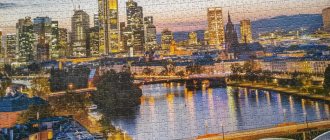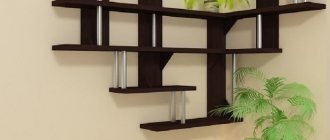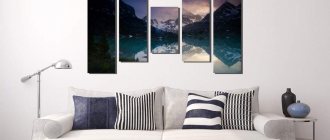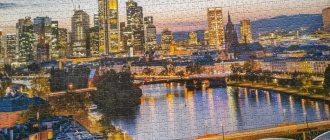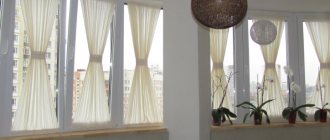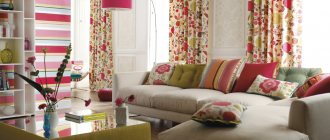Small objects such as photographs, pictures, shelves and hooks can be mounted on the wall in two ways - by drilling holes in the wall and without drilling. There are two types of methods without drilling - permanently attached and removable.
Permanent fastening is performed by gluing the picture frame to the wall using double-sided tape, adhesives and liquid nails. The disadvantage of this technology is low reliability and the impossibility of simply removing an object to hang it on another place on the wall in the apartment. Therefore, I prefer to mount objects on the wall using a mechanical method using available materials, and I decided to share examples of this method of fastening.
Optimal placement of paintings in the interior
Mounting for pictures on the wall depends on three parameters:
- Reliability of the wall material.
- The strength of the connection between the mount and the wall.
- Strength of adhesion of the frame or canvas to the fastening.
The wall where the picture is attached can be made of wood, stone materials, plasterboard, lined with ceramic tiles, covered with wallpaper or simply painted.
If you can simply hammer a nail or screw a screw into wood, then with concrete such fixation is difficult or impossible. In this case, wall mounts are used without drilling.
In order to attach 8 pictures to the stand, for example, small engravings, you can use a regular or decorative paper clip or a strip of tape.
To solve the problem of how to hang a picture on a wall of medium size and weight, you will need special fasteners that can withstand a force of 3-5 kg.
Large works (mosaics, panels, bas-reliefs) will require fastenings designed for 10-15 or more kg. And in order to hang a heavy frame with a huge canvas weighing several tens of kilograms, it is necessary to use a special design.
Selecting a location
Placing canvases indoors involves a dual task:
- Convenience of their contemplation for obtaining aesthetic pleasure.
- Complementing and decorating the interior, creating a special atmosphere in the room.
Choosing a place for a painting will be more difficult if there is not one painting, but many. In such cases, it is necessary to allocate special areas for them. At the same time, in order to attach several paintings to a common stand, you have to spend a lot of time and effort so that the composition looks holistic and is in harmony with the rest of the room.
As a rule, paintings are placed in open, visible places. The distance between them and other interior elements is usually selected based solely on the taste of the owners.
The situation is complicated by fasteners, but at the same time made easier by the choice of location, when drawings, photographs, etc. are placed last. Furniture has already been arranged, lamps have been installed, curtains or blinds are hanging. The process of choosing a location boils down to the fact that the masterpiece is alternately placed in different places. They stop at the one that seems most suitable.
It is worth remembering that a large canvas with a massive frame looks ridiculous in a small room. Just like a small picture on a large empty plane.
It is desirable that the plot corresponds to the purpose of the room. Completely different creations are suitable for the interiors of the living room, bedroom, and kitchen.
It is also necessary to take into account that works with landscape orientation, elongated horizontally, visually “eat up” the width of the room, but lengthen the space, while vertically oriented works add height to the room.
Backlight
It is used in cases where the impression of the picture should not depend on the time of day, or when ordinary lighting is not enough. It can work either continuously or turn on as needed.
Original Toly hook
The manufacturer of this fastening system assures that Toly hooks are ideal for any surface: brick, concrete, wood. Even children can hammer in the hook, and if there is a need to rehang a picture, the Toly hook will not leave behind an unsightly hole in the wall. The hook is easily pulled out and leaves behind only a small, unnoticeable hole. The advantages of this mount include the following qualities: affordable price, various sizes for different weight loads.
Traditional methods of mounting pictures
In most cases, to hang a picture, they use a time-tested technique that is suitable for all types. This is a nail driven into the wall at an angle. The canvas is suspended from it using a special loop or cord. The wall can be anything.
On a wooden wall
Even if the wall is plastered, the metal fasteners fit in quite easily. But in order not to leave sloppy chips on the plaster, it can be pre-drilled. A screw is screwed into the hole, an “L” shaped curved at the end, or ending in a half ring, or a nail is simply driven in.
The thickness of the nail depends on the weight of the painting.
On concrete
The option that causes the greatest difficulty, since to drill a hole you need a hammer drill or at least a hand tool called a “bolt” - a hardened steel tube with teeth at the end.
A regular plastic dowel is inserted into the hole, into which the bolt hook is then screwed.
For particularly heavy paintings, you can use an expansion anchor. This is a tube, 5 cm long, along the entire length of which runs a bolt ending with a screwdriver head, nut, or hook.
When the rod rotates, the plug moves along the thread and expands the tube, fixing it securely.
On the brick
It is easier to drill into brick than into concrete. Therefore, a drill with a diamond or pobedite drill bit is suitable.
After the hole is drilled, a dowel with an anchor or an expansion bolt is used, as when fastening to concrete.
In addition to the methods listed above, you can drive a special hardened nail into the brick. Usually a mounting gun is used for driving, but it can be driven into a brick wall with an ordinary hammer.
On drywall
Self-tapping screws and nails are easily screwed into plasterboard sheet (GKL), but the material itself is fragile and does not hold this type of fastener securely. To hang heavy pictures you need to use special anchors.
For small ones, plastic plugs of various designs, dowel-nails, as well as expansion anchors of the “butterfly” type and the like are used. But even in this case, the weight that the mount can support usually does not exceed 15 kg.
If the canvas is heavy, it is recommended to attach it to a load-bearing wall. And if this is not possible, then an additional reinforcing structure - a frame - should be installed. Such actions require a significant investment of time, money, and special skills.
Decoration stage
Once the position of all elements has been approved, it’s time to move on to the fasteners. You can make marks at the corners to hang the images exactly as intended. All that remains is to choose the right mount and see your old empty wall as new, bright and beautiful. For example, like this:
We want any interior transformation process to be easy and fun. So that nothing stops you on the path to realizing your ideas. And if you've always dreamed of bright walls that, like a mirror, reflect your character, maybe now is the time to start? We hope our article will be useful to you in this regard.
How to hang a picture without a hole in the wall
Most paintings that have to be hung in residential or public spaces are not particularly massive and, even together with the frame, do not weigh more than 3-5 kg. The load from engravings and small photographs sometimes does not reach a kilogram.
Some interesting devices allow you to hang a picture on the wall without drilling.
Special Velcro
Clothing Velcro, designed like a burdock, has become widespread. They consist of two elements: on one there are many tiny plastic hooks, on the other there is a fleecy surface on which these hooks easily cling.
If necessary, by applying a certain force, these parts come apart with a quiet crack, but can be reconnected.
Attaching to wallpaper using a paper clip or sewing needle
If you have practically nothing at hand to attach the picture, a regular paperclip or even a sewing needle will do.
The only limitation is the need for dense, preferably embossed, wallpaper and
To fasten with a paper clip, the following manipulations are performed:
- Using a sharp knife, make a horizontal slit in the wallpaper.
- A narrow, thin object (for example, a steel manicure file) is inserted into the gap from top to bottom in order to carefully tear the wallpaper off the wall to the length of a paper clip.
- Then the paper clip needs to be bent a little and, generously coated with PVA or Moment glue, inserted under the wallpaper, and then pressed tightly.
With a needle the situation is simpler. It needs to be bent, inserting halfway into any narrow gap in the house. The deflection angle is about 15°. After this, insert the needle from top to bottom into the wallpaper, leaving an end 1-1.5 cm long outside.
Features of non-standard paintings
In addition to the usual paintings, consisting of a frame with a painting stretched over it, there are also “non-standard” ones, that is, differing in the design itself. Two types of arrangement of such paintings can be distinguished.
No frame
It could be a pencil drawing, watercolor, engraving or even an unusual calendar. The weight of such paintings is usually small and they can be placed on the wall by securing them with ordinary push pins. Possibly with decorative heads.
Often there is an option when the frame is hidden, or rather its role is played by the internal frame, which gives the picture rigidity. In this case, the methods described above are suitable for mounting on the wall.
For lightweight products, these can be Velcro; for larger ones, they can be anchors and hinges that are attached to the frame with glue, small screws or nails.
Modular
It is a composite fabric. Each individual block has a part of a larger picture drawn on it. The task of how to attach a modular picture to a wall is complicated by the fact that its elements must be located in strict accordance with each other.
For this purpose it is convenient to use a common guide rail. It is attached to the wall or ceiling in the usual way using anchors or dowels. Then strong cords are attached to this bar, on which parts of the picture are in turn hung.
Such fastening for modular paintings is also convenient because the adjustment of the component blocks can be done extremely accurately, both vertically and horizontally.
If the guide strip violates the design of the room, parts of the modular picture can be hung using one of the methods described above, but this will require scrupulous markings, otherwise the disharmony of poorly joined blocks will negate all the work. Therefore, it is better to entrust the installation of a modular picture to professionals.
Command Wall Fasteners
Do you urgently need to hang a photo frame or other light decorative item? No problem, use adhesive tape closure. You don't even need a drill or hammer for this.
Wall fasteners look like Velcro, the surface of which is covered with a protective film. Fasteners are sold in sets, the minimum number of pieces is 4. Before using, use scissors to separate them from each other. Next, connect the 2 pieces together and remove the protective coating from them. Attach it to the object with one side, and apply the other sticky side to the wall.
Hold on each side for at least 30 seconds. Fast and convenient. But this method of fastening has its drawbacks. It does not attach well to non-woven and vinyl wallpaper, which means this method is not suitable for all surfaces.
They are attached to paper ones very firmly, but after removing them from the wall they may leave minor marks. The disadvantage is that this method is used only for paintings of small weight, up to about 500 grams. The price of the product is 200 rubles for 4 pieces.
Methods for attaching heavy paintings
Fixing a fairly large painting weighing 15-20 kg will not be a problem: a regular tubular anchor with a diameter of 12 mm can support up to half a ton. However, not every wall can withstand such weight.
If the wall material is plasterboard or foam concrete plates, special easels will have to be built to install heavy bas-reliefs, mosaics, paintings in metal frames.
To do this, racks made of wooden beams or profile pipes are installed between the floor and ceiling, fastening them together. The picture is hung on this device and its weight is distributed over many points at once.
This type of mounting is usually found in galleries.
For any painting or other work it is possible to choose a reliable mount. The installation itself may require the use of special tools. But no instrument can replace aesthetic taste and a sense of proportionality.
Did you manage to solve your problem using the recommendations from the article?
Yes!
46.39%
No. More answers required. I'll ask in the comments now.
38.56%
Partially. There are still questions. I'll write in the comments now.
15.05%
Voted: 804
Adhesive tape
If you don’t have Velcro fasteners on hand, you can use double-sided tape. It is important to know that the surface must be smooth for this type of fastening. The principle of operation of double-sided tape is the same as that of Velcro.
Scotch tape is more economical in its use and will last for a greater number of uses. Apply tape around the perimeter of the picture or photo frame and remove the protective layer. Next, press the object firmly against the wall and hold for about 30 seconds.
Depending on the density of the tape, it can be used on almost any surface. For example, masking tape is denser and, therefore, can withstand greater loads. But just like Velcro, tape can leave marks behind and damage the coating. To avoid damaging the coating, use the following advice: remove the adhesive tape from the wall perpendicular to the wall.
Then the likelihood that you will remove the coating along with the tape is very small. The huge advantage of this method is that it can be used to change the location several times, without additional holes in the wall.
Professional solution
If “artisanal” hanging methods are not satisfactory and you want to know how to properly install the fasteners – following the example of art galleries – it’s worth remembering special hanging systems.
They consist of three main elements - a rail, a strong fishing line or cable, and a hook with a regulator. Thanks to this regulator, you can set the desired position of the hook - at a greater or lesser distance from the rail.
The systems are complemented by connecting, end and corner elements, which makes it possible to position the rail along the entire perimeter of the room, not excluding corners, bay windows and protrusions.
For large and heavy images, craftsmen advise using two hooks: this helps to hang the frame evenly and is especially suitable for heavy products.

